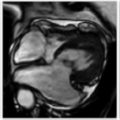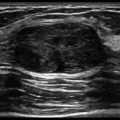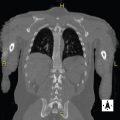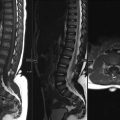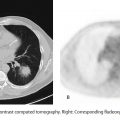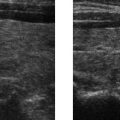SECTION XV ARTIFACTS IN IMAGING
Magnetic Resonance Imaging Questions
1. When the k-space trajectory is linear, motion artifacts most commonly occur in which direction?
A. Slice encode
B. Phase encode
C. Frequency encode
D. Oblique to image plane
B. Correct! Motion artifacts tend to occur in the phase encode direction. Remember that during each repetition time (TR), in conventional readouts, a line of k-space is acquired that is at one phase encode level and across the readout or frequency encode direction. Thus, readout for the frequency encode direction is much faster as it occurs within a TR, instead of for the phase encode direction that occurs across TRs. Basically, there is a higher chance for the motion artifact to accrue for the phase encode data than for the frequency encode data—and that artifactual data gets repeated or smeared across the phase encode direction.
2. Of the techniques listed below, which CANNOT typically mitigate motion artifacts?
A. Saturation bands
B. Radial versus conventional k-space trajectories
C. Increasing receiver bandwidth
D. Flip phase and frequency directions
C. Correct! That is, increasing receiver bandwidth cannot mitigate motion. There are many tricks to mitigate motion artifacts. Saturation bands can be used to null the signal from the offending moving objects (e.g., bowel and vasculature anterior to the lumbar spine). Radial acquisitions can be used, generally with oversampling of the origin, to prevent a single faulty line of k-space from coming through in the final image. Because motion artifacts occur in the phase encode direction, flipping which direction is used for frequency versus phase encoding can flip the direction in which the artifact is produced, allowing for better visualization of the target lesion. Conversely, with motion artifacts, altering bandwidth has minimal effect.
3. Of the following, which WOULD NOT minimize a metal-related artifact?
A. Higher field strength
B. Use of short T1 inversion recovery for fat suppression
C. Parallel imaging
D. Increasing receiver bandwidth
E. Shorter time to echo or echo delay time
A. Correct! That is, higher field strength cannot minimize metal artifact. With a metal artifact, the magnetic susceptibility of the metal causes alteration of the local magnetic field, resulting in a dramatic T2*-related loss of signal. In general, susceptibility artifacts increase with field strength. Thus, increasing the field strength is the only answer choice provided that would be expected to increase the artifact.
4. Which of the following techniques is the LEAST sensitive to a metal-related artifact?
A. Convention spin echo
B. Gradient echo
C. Fast spin echo
D. Fat saturation
C. Correct! That is, fast spin echo is the least sensitive technique to a metal-related artifact. Gradient echo sequences are highly sensitive to T2* effects, such as metal artifacts. Fat saturation relies on precise estimation of the precessional frequency differences between fat and water protons. Metal causes artifacts by altering the local magnetic field (and, therefore, the local precessional frequencies), thus rendering fat saturation useless. The multiple 180-degree pulses of fast spin echo cause multiple rounds of refocusing and reduced spin J-coupling. This reduces the dephasing that leads to the T2- and T2*-related signal loss and image warping seen in metal artifacts. Therefore, fast spin echo is less sensitive to metal artifacts than conventional spin echo.
5. Of the following, which would be INEFFECTIVE in addressing aliasing (“wraparound” artifact)?
A. Increasing the field of view
B. Increasing the matrix size
C. Increasing the bandwidth
D. Assigning frequency encode to the largest dimension of the patient
C. Correct! That is, increasing the bandwidth would not correct the aliasing artifact. In aliasing (aka “wraparound” artifact), objects outside of the FOV contribute signal that is detected by the receiver coil, and the system misinterprets that extraneous signal as originating from within the FOV. This localizes that signal to the opposite side of the image (i.e., the image “wraps around” to the other side). In general, the wraparound artifact is seen in the phase encode direction, as the problem of aliasing is easier to prevent or remedy in the readout direction. This is accomplished by increasing the FOV and matrix via increasing the sampling during readout, which takes into account the extra signal received. Fixing the artifact in the phase encode direction would require more phase encode steps and therefore would increase the net scan time. By assigning the frequency encode to the largest patient dimension, only a minimal number of phase encode steps are needed to encompass the matrix necessary for the entire FOV. This minimizes the chance for aliasing. Additional remedies for aliasing include the use of a coil with sensitivity only over the FOV and/or the use of selective excitation to excite only a slab in the desired region. Keep in mind that because there are two phase encode directions for three-dimensional sequences, aliasing can occur in either direction, producing some rather strange artifacts!
6. Which of the following corrections is most helpful in removing a “magic angle” artifact?
A. Increasing the number of averages
B. Increasing the parallel imaging factor
C. Increasing the echo time
D. Increasing the echo train length
C. Correct! With the “magic angle” artifact, when an ordered structure that has a short intrinsic T2 relaxation time is oriented at a particular angle with respect to the magnetic field, certain forms of spin-spin coupling are reduced. This lengthens the T2 relaxation time of the structure. The lengthened T2 time translates to an increased amount of time for the transverse magnetization to persist, which yields slightly increased signal, given that signal is proportional to the amount of transverse magnetization. By increasing the echo time to produce a T2-weighted fat-saturated image, the effect of that slight T2 lengthening and transverse magnetization is removed or, at the very least, is imperceptible.
7. The “magic angle” artifact most frequently occurs when a tendon or ligament is at a
A. Approximately 90-degree angle to the main magnetic field
B. Approximately 55-degree angle to the main magnetic field
C. Approximately 90-degree angle to the readout direction
D. Approximately 55-degree angle to the readout direction
B. Correct! The “magic angle” of the magic angle artifact is ~ 54.7 degrees (or, written another way, 180 degrees − 54.7 degrees = 125.3 degrees) with respect to the main magnetic field. This artifact can occur when an ordered, short T2 structure (i.e., tendon or ligament) is oriented at this angle regardless of the imaging plane. Thus, the artifact may arise in that anatomic location even if imaging was performed in the axial or coronal plane—not just in the sagittal plane.
8. In spin-echo imaging, enhanced T2 weighting of image contrast can be achieved by:
A. Increasing echo time (TE) and increasing repetition time (TR)
B. Increasing TE and decreasing TR
C. Decreasing TE and increasing TR
D. Decreasing TE and decreasing TR
A. Correct! Generally speaking, increasing the TE increases T2 weighting in spin echo imaging, whereas decreasing the TR increases the T1 weighting. Therefore, to produce a T2-weighted spin echo image, a long TE is used to maximize T2 weighting, and a long TR is used to minimize T1 weighting.
9. All other things being equal, which of these sequences would have the highest signal-to-noise ratio?
A. Short repetition time (TR), short echo time (TE)
B. Short TR, long TE
C. Long TR, short TE
D. Long TR, long TE
C. Correct! Generally speaking, relaxation effects reduce signal strength. Therefore, for conventional imaging, a long TR would minimize T1 relaxation-related effects, whereas a short TE would minimize T2 relaxation-related effects. Note that these choices would produce a proton density–weighted image. Proton density–weighted images are among the higher signal-to-noise ratio sequences in magnetic resonance imaging.
10. Of the following, which would decrease magnetic resonance imaging slice thickness?
A. Increasing the receiver bandwidth
B. Increasing the transmit bandwidth
C. Increasing the slice-select gradient
D. Increasing the field strength
C. Correct! Slice thickness during selective excitation is a function of the strength of the slice-select gradient and the transmit bandwidth. In slice selection, a “slice-select” gradient is turned on so that there is a gradient of field strength along the direction of slicing. This results in a gradient of precessional frequencies that run along that axis. For instance, in axial slicing, the slice-select gradient is oriented along the head-to-foot axis so that the spins in the head are precessing slower than those in the feet, or vice versa. Then a radiofrequency pulse is transmitted that is tuned to the frequency of the spins in the section of tissue (or slice) that are meant to be selected. The width of the slice will then depend on the range of frequencies included in the radiofrequency pulse (i.e., the transmit bandwidth) and how steep the gradient is across the thickness of the subject. Slice thickness increases with increasing transmit bandwidth and with decreasing slice select gradient.
11. Of the artifacts listed below, which relates directly to in- and out-of-phase imaging?
A. Chemical shift, type 1
B. Chemical shift, type 2
C. Magic angle
D. Flow-related dephasing
B. Correct! The differences in the precessional frequencies of fat and water protons underlie the two types of chemical shift artifact (the chemical shift refers to the shift of the frequencies of fat protons with respect to water). In the type 1 chemical shift artifact, the signal from fat is misregistered such that it is translated along the frequency encode direction, showing up as a bright band on one side of a water-containing structure surrounded by fat and as a dark band on the opposite side. In the type 2 chemical shift artifact, fat and water protons accrue different phases during precession. Therefore, at different and predictable times, the protons are alternately in-phase (in which case their signals add up within a given voxel) or out-of-phase (in which case their signals cancel within a given voxel). In- and out-of-phase imaging takes advantage of these phase differences by acquiring echoes at the expected in- and out-of-phase times (at 1.5 T: out-of-phase = 2.2, 6.6, 11.0, … ms; in-phase = 4.4, 8.8, 13.2, … ms). If a voxel has less signal on the out-of-phase image than on the in-phase image, then that voxel must contain water and fat protons in a roughly equal mixture.
12. Which of the following relationships between relaxation and main magnetic field strength (B0) are correct?
A. Proton density (PD) increases substantially and T2 decreases substantially with increasing B0
B. PD and T2 decrease substantially with increasing B0
C. T1 increases substantially and T2* decreases substantially with increasing B0
D. T2 and T2* increase substantially with increasing B0
C. Correct! For clinical purposes, PD and T2 relaxations are essentially independent of factors such as the strength of the main magnetic field (B0). T1 relaxation time increases with increasing B0 because the Larmor frequency increases. The energy transfer that mediates T1 relaxation is most efficient when molecules are tumbling at a rate close to the Larmor frequency. As the Larmor frequency increases, fewer and fewer molecules near the spin are available to mediate T1 relaxation, so the T1 relaxation time is prolonged. Similarly, at higher field strength, the spins are spinning faster, and the slight phase differences that mediate the dephasing that in turn mediates T2* effects accrue faster. Therefore, at higher field strengths the spins de-phase faster, making T2* shorter.
13. How often should the magnetic resonance magnet be powered down and restarted?
A. Daily
B. Weekly
C. Annually
D. Never
D. Correct! Turning the magnet off is known as “quenching” and involves boiling off the liquid helium that keeps the wires of the electromagnet cold. This increase in temperature leads to a sudden loss of superconductivity. If the room is not suitably vented, a quench can result in frostbite and asphyxiation for those unlucky enough to be in the scanner room. Quenching is an extraordinarily expensive process. In addition, because wire resistance is zero in the superconducting state, once current has been established in an electromagnet, it will not dissipate unless disrupted by someone. Therefore, a routine magnet shut down is not needed. From a safety perspective, it should always be assumed that the magnet is on.
14. Of the following, which value for estimated glomerular filtration rate (eGFR) would generally be an absolute contraindication to administration of a gadolinium (Gd)-based contrast agent (GBCA)?
A. 80 mL/min/1.73 m2
B. 60 mL/min/1.73 m2
C. 40 mL/min/1.73 m2
D. 20 mL/min/1.73 m2
D. Correct! Nephrogenic systemic fibrosis (NSF) is a rare disorder that appears to be related to Gd deposition in patients with renal dysfunction. In patients with low eGFR, without adequate clearance of the GBCA, it is hypothesized that GBCAs dissociate, resulting in deposition of ionic Gd (Gd31) in tissues, inducing a toxic reaction that results in systemic fibrosis. In support of this, it is noted that the rates of NSF have dramatically declined with newer agents that do no dissociate as readily as older agents. Almost all cases of NSF have been seen in patients with eGFR < 30 mL/min/1.73 m2, with only a few cases identified in patients with eGFR = 30 to 60 mL/min/1.73 m2. No cases have been seen in patients with eGFR > 60 mL/min/1.73 m2. For these reasons, guidelines indicate that an eGFR < 30 mL/min/1.73 m2 is an absolute contraindication to GBCA administration unless hemodialysis will be performed soon after administration. 1 For patients with eGFR = 30 to 60 mL/min/1.73 m2, the decision to administer a GBCA is at the discretion of the radiologist. In patients with eGFR > 60 mL/min/1.73 m2, Gd administration is considered safe.
15. Which of the following changes would increase magnetic resonance imaging specific absorption rate (SAR)?
A. Decreasing the main magnetic field strength (B0)
B. Decreasing the repetition time (TR)
C. Decreasing the flip angle
D. Decreasing the total scan time
B. Correct! In magnetic resonance imaging, SAR refers to the rate of energy deposition, principally due to radiofrequency (RF) energy transmission. This deposition rate is directly proportional to the square of the RF amplitude and time, and inversely proportional to the TR. Note that flip angle increases proportionately with RF amplitude and duration, such that SAR increases with the flip angle. Also, because the Larmor frequency increases with field strength (B0), and RF energy increases with frequency, SAR also increases at higher field strengths (if everything else is equal). Note that the total scan time does not affect SAR, as SAR measures the rate of energy deposition, not the total amount of energy deposited. In summary, SAR is proportional to [B0 2 · (flip angle)2]/TR. Additionally, since higher RF power is generally needed to penetrate deeper tissues, SAR generally increases with patient size.
16. If a patient experiences a cardiac arrest during a magnetic resonance imaging (MRI) scan, which of the following procedures should be followed?
A. Remove patient from scanner gantry and relax zoning restrictions to allow unscreened code personnel to enter Zones 2 and 3 but not Zone 4
B. Remove patient from scanner gantry and relax zoning restrictions to allow unscreened code personnel to enter Zone 2 but not Zones 3 and 4
C. Remove patient from scanner gantry and relax zoning restrictions to allow unscreened code personnel to enter Zones 2, 3, and 4
D. Remove patient from scanner gantry past the five Gauss line so that no relaxation of zoning restrictions is necessary
D. Correct! The MRI zones are meant to help ensure that only screened personnel or devices enter the scanner room and thereby experience the potential risks of the high magnet field strengths. Because the magnet is always on, the MRI zones are never relaxed—even during a code. Typically, the five Gauss line is considered to be the mark beyond which the environment is considered safe. Therefore, during a code, the patient should be removed beyond the five Gauss line as safely as possible to facilitate the administration of proper emergent care without the worry of device and/or personnel compatibility with MRI.
17. Match each of the structures on the right (1 to 4) with its role in magnetic resonance imaging generation (A to D).
A. 3
B. 4
C. 2
D. 1
Water and air pass through waveguides to get into and out of the scanner room in a manner that prevents spurious RF leak. Electrical signals pass through filters for the same reason. Shielding is used to electrically isolate the scanner room so that electromagnetic fields do not enter the room (and cause noise) or leave the room (where they can interfere with other medical devices, such as pacemakers). Keep in mind that shielding must occur in all three dimensions, as electromagnetic fields are three-dimensional. “Shimming” is used to make the B0 and B1 fields more homogeneous and linear, respectively.
18. Match each of the sequences (A to C) with its description (1 to 4). (One of the sequences can be used twice.)
A. Fat saturation
B. Dixon method
C. Inversion recovery
Start sequence at fat null point after a suitable preparatory sequence
Apply a frequency selective pulse of random phases to prevent fat signal generation
Best for when metal is present
Use chemical shift type II to calculate fat-only and water-only images
A. 2
B. 4
C. 1, 3
All of the methods listed are performed for fat signal nulling. Because metal alters the local magnetic fields and, therefore, the local precessional frequencies for fat and water, inversion recovery is the best method for fat nulling in the presence of metal.
19. Match each of the sequences on the left (A to D) with its repetition time (TR) and echo time (TE) characteristics on the right (1 to 4).
A. T2-weighted
1. Spin echo short TR, short TE
B. Proton density–weighted
2. Spin echo long TR, long TE
C. T1-weighted
3. Spin echo long TR, short TE
A. 2
B. 3
C. 1
In spin echo imaging, long TE weights toward T2 contrast. Short TR weights toward T1 contrast. Proton density–weighted images are generated with weighting away from both T1 and T2 contrast. In gradient echo imaging, small α (flip angle) yields more T1 weighting—as does short TR, but TR is generally set to be the minimum possible for gradient echo. Long TE yields more T2* weighting. Note that because of the longer TE for T2* sequences, the TR is necessarily longer than for T1 weighting. For proton density–weighted images, we weight away from both T1 weighting and T2* weighting by using small α and short TE.
20. Match each of the contrast mechanisms on the left (A to E) with its pulse sequence implementation on the right (1 to 5).
A. 2
B. 3
C. 5
D. 1
E. 4
In addition to their usual role in encoding spatial information in the eventual signal, gradients can do a variety of other things as listed above.
21. Of the characteristics listed below, which apply(ies) to spoiled gradient echo? (Select ALL that apply.)
A. Partial saturation
B. Uses the residual transverse magnetization
C. Spoilers
D. Rewinders
E. Steady state transverse magnetization
A and C. Correct! Advanced gradient echo pulse sequences, like spoiled gradient echo and steady state free precession or coherent gradient echo, build upon the base gradient echo sequence to generate contrasts that are not usually available to gradient echo sequences. When the radiofrequency pulses are placed close enough together, a steady state of longitudinal or transverse magnetization (or both) may develop. Advanced gradient echo sequences differ in how they use or eliminate these steady states. Spoiled gradient echo sequences use spoiling to eliminate the residual transverse magnetization in each repetition time, but then maintain a steady state longitudinal magnetization that is generally less than the amplitude of the original magnetization. This situation is known as partial saturation. Steady state free precession sequences specifically maintain the residual transverse magnetization to create a steady state of transverse magnetization, with rewinder gradients used to select the appropriate portions of k-space.
22. Which of these physiological factors is LEAST directly assessed with routine functional magnetic resonance imaging?
A. Cerebral perfusion
B. Blood oxygen extraction
C. Neuronal activity
D. Blood oxygen saturation
C. Correct! That is, neuronal activity is least directly assessed. Blood oxygenation level–dependent (BOLD) contrast is the main form of functional magnetic resonance imaging currently in use. As the name implies, BOLD is fundamentally a measure of blood flow and blood oxygenation levels. The basis of the contrast mechanism in BOLD is that deoxygenated blood has higher susceptibility and is therefore darker on a T2*-weighted image than oxygenated blood. Through the phenomenon of neurovascular coupling, neuronal activity induces changes in cerebral perfusion that are detectable with the BOLD technique. Keep in mind that BOLD, while a very powerful technique, only indirectly visualizes brain (neuronal) activity.
23. Which of the following would generally increase the signal-to-noise ratio? (Select ALL that apply.)
A. Increasing voxel size
B. Increasing slice thickness
C. Increasing receiver bandwidth
D. Increasing main magnetic field
A, B, and D. Correct! Signal-to-noise ratio increases with voxel size and volume, increases with the strength of the main magnetic field, and decreases with the receiver bandwidth.
24. Which of the following is generally most helpful when determining whether to perform magnetic resonance imaging (MRI) on a patient with a metallic implant?
A. Prior MRI completed without issue
B. Operative note from device placement
C. Computed tomography of the region of interest
D. Signed statement from the patient agreeing to the MRI
B. Correct! Ultimately, the decision whether to scan a particular patient on a particular scanner is at the discretion of the radiologist. The only way to be sure whether a particular device or implant is MRI-safe is to have documentation of the exact model of the implanted device, documented in the surgeon’s or interventionalist’s operative note from the device placement. This data then can be checked against databases that compile assessments of MRI device safety, such as mrisafety.com. Relying upon reports of a prior MRI or a history obtained from the patient is insufficient. A computed tomography of the region would help to determine if there is metal in the device, but would not help to clarify the safety.
25. Regarding diffusion imaging, which of the following is FALSE:
A. The b = 0 image is essentially a spin echo T2-weighted image.
B. The high b-value image shows a mixture of diffusion and T2-weighting.
C. The apparent diffusion coefficient (ADC) image is typically produced by a combination of diffusionencoding gradients with an echo planar readout.
D. The acquisition of a diffusion tensor image is essentially the same as for a diffusion-weighted image, except for the inclusion of more gradient directions.
E. Any readout (conventional, spiral, echo planar, etc.) can be used for diffusion imaging.
C. Correct! That is, the ADC is not produced by the diffusionencoding gradients. The other statements are all true. Diffusion imaging is accomplished by applying a motion encoding gradient sequence coded along a particular gradient direction that is formed by the sum of amplitudes of the individual x, y, and z gradients. The strength and timing of these gradients defines the “b value,” with a high b-value indicating high sensitivity of that sequence to restricted proton movement or diffusion. The signal produced by this motion encoding can be read out using any particular readout, although echo planar readout is used most commonly because of its speed. In diffusion-weighted imaging, multiple (at least six) gradient directions are acquired and averaged together to remove the effects of anisotropy biasing the signal. The diffusion-weighted image that is produced will contain a mixture of T2-weighting and diffusion weighting. To assess the T2-weighting, typically a “B0” image is calculated wherein b = 0, i.e. the motion-encoding gradients are not turned on. When b = 0, the sequence run is a regular T2-weighted spin echo sequence with otherwise the same technical parameters and readout as the diffusion-weighted image. Between the diffusion-weighted image and the B0 (T2-weighted) images, an ADC image can be calculated that is more purely a reflection of the diffusion characteristics of the tissue, without T2-weighting. This ADC “map” is a calculated representation and is not directly produced by a sequence from the scanner. For diffusion tensor imaging, many more gradient directions are acquired and steps are taken to specifically calculate the degree of anisotropy in different directions.
26. Of the following, which would NOT be expected to show high relative diffusion signal?
A. Infarcted tissue
B. Abscess
C. Hypercellular tumor
D. Lymphocele
E. Mucocele
F. Hematoma
D. Correct! That is, lymphocele will not show high relative diffusion signal. High signal can be seen with high protein content, as with abscesses and mucoceles. High diffusion signal can be artifactually increased in regions of increased susceptibility, as in hematomas. Simple fluid (as is found in lymphoceles) would not be expected to restrict diffusion or yield high diffusion signal.
27. Gadolinium-based contrast agents are relatively contraindicated in evaluating pregnant patients because:
A. The contrast agent can cross the placenta and reach the amniotic fluid, where gadolinium may disassociate from its chelating agent and adopt its toxic ionic form.
B. Relatively reduced renal function in pregnancy would limit the renal clearance of the contrast agent and make the pregnant mother at risk for nephrogenic systemic fibrosis.
C. Relatively reduced hepatic function in pregnancy would limit the hepatic clearance of the contrast agent and make the pregnant mother at risk for nephrogenic systemic fibrosis.
D. The contrast agent can cross the placenta and directly interfere with cell division, limiting organogenesis.
A. Correct! The toxic form of gadolinium is the free ionic form (Gd31). Normally, gadolinium in contrast agents is bound by a chelating chemical cage that prevents toxicity. The kidney and (to a lesser extent) the liver then eliminate the gadolinium from the body. Given enough time, gadolinium will dissociate from its chemical cage into its toxic ionic form. Thus, gadolinium toxicity occurs when the caged gadolinium is not promptly eliminated and the retained molecule has enough time to dissociate into its toxic ionic form. This occurs in patients with renal failure (estimated glomerular filtration rate < 30), which is the basis for nephrogenic systemic fibrosis. This can also occur in the fetus, as the caged gadolinium crosses the placenta into the fetal circulation, is eliminated by the fetal kidneys into the amniotic fluid, but then has nowhere to go but back into the fetus. Eventually, the gadolinium in the fetal tissues and circulation will dissociate into its ionic form, which can be toxic to the fetus.
28. Which of the following statements regarding contrast-enhanced perfusion is INCORRECT?
A. Cerebral blood volume (CBV) is calculated as the area under the curve between the baseline of the signal and the contrast bolus peak.
B. Time to peak (TTP) refers to the time when the maximal signal change occurs measured from the start of imaging.
C. Perfusion magnetic resonance imaging can only produce relative quantifications for each of CBV, TTP, mean transit time (MTT), unless the arterial signal is directly measured and accounted for.
D. Cerebral blood flow is calculated as the MTT/CBV.
E. The MTT refers to the width of the contrast bolus peak at its mean or half of the maximal peak change from baseline.
D. Correct! That is, cerebral blood flow is not calculated at MTT/CBV. In contrast-enhanced perfusion, whether computed tomography or magnetic resonance imaging, several values are calculated from the shape of the curve of signal derived from each voxel as the contrast passes through it. Cerebral blood flow is equal to CBV/MTT, not MTT/CBV. The CBV is derived from the area under the curve between the bolus and the imaginary line connecting the baseline level of signal before and after the bolus. The TTP, or Tmax, is the time at which the bolus attains its peak. The MTT is the width of the contrast bolus, generally taken at the half-maximum level. Note that only relative values of each of these parameters can be calculated, unless the curves can be corrected using the arterial input function of the signal from the arteries feeding each territory.
29. Of the following, which is TRUE regarding arterial spin labeling (ASL) and conventional perfusion magnetic resonance imaging sequences?
A. Both techniques require contrast administration, although less is needed for ASL.
B. Current quantification methods only allow the calculation of relative cerebral blood flow (rCBF) when ASL is used.
C. Only contrast-enhanced perfusion imaging methods have a role in tumor evaluation, whereas both ASL and contrast-enhanced imaging methods can be used in stroke evaluation.
D. ASL requires magnetic resonance imaging systems with at least 3 Tesla magnetic field strength, whereas conventional perfusion methods can be completed using most any magnetic field strength.
B. Correct! ASL is a noncontrast perfusion imaging technique. In routine clinical practice, only rCBF is calculated from ASL. ASL can be used for any evaluation in which perfusion assessment is helpful—it is as much a technique for perfusion imaging as is contrast-enhanced perfusion imaging. The primary functional difference between ASL and conventional contrast-enhanced perfusion is that ASL is an overall lower signal imaging technique and the images produced are blurrier and sensitive to a variety of technical artifacts.
30. Which of the following distinguishes two-dimensional (2D) sequence acquisition from three-dimensional (3D) acquisition?
A. Three-dimensional sequences require a magnetic resonance imaging system of at least 3 Tesla, whereas 2D sequences can be completed using any field strength.
B. Three-dimensional sequences have two phase encoding directions and one readout direction, whereas 2D sequences have one of each.
C. Three-dimensional sequences have necessarily reduced signal-to-noise ratio compared to 2D sequences.
D. Three-dimensional sequences are generated with specialized 3D coils, whereas 2D sequences can be used with any routine coil.
E. Slice or slab selective excitation is never completed with a 3D sequence, whereas it is necessary for 2D sequences.
B. Correct! In 3D magnetic resonance imaging, a second phase encode direction is included in the sequence to allow coding along two phase encode dimensions and one frequency encode direction simultaneously. This allows all three dimensions to be imaged at once.
31. Which of these quantities most directly affects contrast in an inversion recovery sequence?
A. T1
B. T2
C. T2*
D. Proton density
A. Correct! In inversion recovery sequences, a 180-degree pulse is applied initially and then the magnetization is allowed to recover at a T1-dependent rate. This process spreads out the strength of the tissue magnetization vectors according to their respective T1 times, thereby encoding a T1-weighted contrast in whatever signal is ultimately produced.
32. Paramagnetic materials affect tissue contrast by:
A. Shortening T1 only
B. Shortening T2 only
C. Shortening T2* only
D. Shortening proton density only
E. None of the above
E. Correct! Paramagnetic substances yield shortening of T1, T2, and T2* times. Paramagnetic substances have no direct effect on the proton density.
33. Of the following, which is NOT an important patient safety consideration when completing a magnetic resonance imaging examination?
A. Hearing protection (provide ear plugs, muffs)
B. Renal function if gadolinium-based contrast is to be used
C. Peripheral nerve stimulation at high field strength
D. Heating from loops of wire or metal (electrocardiogram wires, orthopedic hardware)
E. Rate of energy deposition (specific absorption rate)
F. None of the above
F. Correct! All of the above factors should be considered with regard to magnetic resonance imaging safety.
34. Echo train length (“turbo factor”) is defined as:
A. The number of slices acquired at once in multislice sequences.
B. The number of images produced in a multiecho spin echo sequence.
C. The number of echoes per repetition time (TR) for a fast spin echo sequence.
D. The number of echoes acquired by different coils in parallel acquisitions.
C. Correct! Echo train length, or “turbo factor” depending on the magnetic resonance imaging vendor you are using, refers to the number of echoes that are acquired within a TR for fast spin echo (aka turbo spin echo) techniques.
35. Of the following, which angiographic term(s) is correctly paired? (Select ALL that apply.)
A. Bright blood: spin echo
B. Dark blood: spin echo
C. Bright blood: gradient echo
D. Dark blood: gradient echo
B and C. Correct! To generate a signal in spin echo imaging, protons must see both the initial excitation radiofrequency pulse—typically 90 degrees—as well as the refocusing 180-degree pulse. Because flowing protons, especially those in vessels, typically do not see both pulses given their movement between slices, and with movement related dephasing, spin echo sequences generally yield a “black blood” technique wherein the vessels appear black on the image. In contrast, in gradient echo sequences, the protons need only see the initial excitation pulse to generate the signal—the latter gradient refocusing steps are not spatially selective. Additionally, the rapidly repeated radiofrequency excitation pulses induce a partial saturation for the stationary tissues in the imaging slab. This results in flow-related enhancement, wherein the unsaturated protons flowing into the imaging volume have higher signal than the stationary background. Thus, gradient echo sequences are generally a bright blood technique wherein the vessels appear bright on the image.
36. Match the sequence (A to C) with its characteristic (1 to 3).
A. Time of flight
B. Phase contrast
C. Contrast enhanced
1. Flow velocity encoding gradients
2. Highest signal-to-noise ratio
3. Flow-related enhancement and partial saturation
A. 3
B. 1
C. 2
In time-of-flight techniques, generally, a T1-weighted (short repetition time) spoiled gradient echo sequence is used to induce partial saturation of the stationary background with accentuation of the signal from the inflowing unsaturated protons—a phenomenon dubbed “flow-related enhancement.” For phase contrast imaging, a bilobed gradient pulse is used so that phase accrual is nulled for stationary protons and rises linearly with speed in that gradient direction. This encodes the component of velocity of the protons in that direction into the phase of those protons, which can be read out in the phase-only reconstructed images. Contrast-enhanced magnetic resonance angiography is generally the highest signal technique given the use of contrast; this high signal-to-noise ratio allows for imaging acceleration for rapid imaging.
37. Of the following, which has the highest intrinsic signal-to-noise ratio?
A. Fluid attenuation inversion recovery
B. T2-weighted
C. Short T1 inversion recovery
D. Turbo inversion recovery
B. Correct! In general, inversion recovery techniques have lower signal than their more conventional counterparts because the remaining non-nulled tissues still have lower net magnetization than they would have had without the inversion recovery preparation.
Stay updated, free articles. Join our Telegram channel

Full access? Get Clinical Tree


